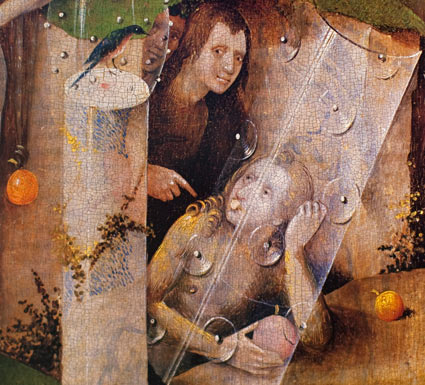Hieronymus Bosch
The Garden of Earthly Delights
The Garden of Delights is one of the only three triptychs of Bosch that were not commissioned by the Catholic Church. Henry III, Count of Nassau, is the most likely patron of this work, however it is also possible that this piece was made on behalf of a heretical sect: the Brethren of the Free Spirit. For this Gnostic sect, the mystery of salvation lay not only in prayer and contemplation, but in the fulfillment of a new Adamic cult capable of turning the carnal union of man and woman into the basis of a second paradise.
The Garden of delight or the reign of love
The sphere that covers the exterior of the triptych is a picture of Earth on the morning of the third day. A hilly expanse, covered in vegetation, where the waters separate from the waters, and where each tree, according to its kind, produces its fruit. God, at the top left of the scene, lost in the shadows of the night, contemplating his creation. However, unlike most conventional paintings that illustrate the general story of Genesis through frozen scenes, Bosch insists on the dynamic processes by which natural phenomena provoke each other. If the land produces vegetation, the grass producing seeds and the trees producing fruit, it is first and foremost because of the water that nourishes the land through its ever-changing state—from liquid to gas— linking the world above, covered in clouds, to the world below, immersed in water.
However, through this dynamism Bosch does not suggest the idea of cycle and self-fertility, but rather he clearly separates the two stages of the process. Between the left panel of the exterior, on which a morning mist shines in the blooming countryside, and the right panel, where thick black clouds gather, Bosch is perhaps suggesting who hides behind each of the panels.
Ipse dixit et facta sunt
For he spoke and they were made
On the back of the

Here Bosch invents an unconventional scenery in which the idea of original sin is abandoned in favor of a more optimistic thought that could be formulated as follows: If Adam and Eve love one another, it is first and foremost because they both love the Christ who brings them together. Only this kind meditation of Christ forever unites the lovers.
Ipse mandavit et creata sunt
He commanded and they were created
Conversely, on the back of the
But the question now arises as to which world Bosch has invented between the two extremes, between the left panel—the double figure, natural and spiritual—and its union with the contrary on the right—the stormy and passionate vanity of the world, the wrath of God. One thing is certain, it appears that Bosch had wanted to suggest that this world exists on a fault line, in a place and time that we do not yet know, but which, for all eternity, exists in the imagination of man.
What is primarily striking in the

But let there be no mistake: this idyllic image is not a representation of a lost golden age, let alone that of an innocent existence ignorant of sin. It is rather like a moving dream of a humanity that is aware of temptation but tries not to succumb to it. This is why evil and suffering continue to exist in places, but always counterbalanced by the prodigality of nature and by the charitable acts that man makes towards his fellow man.
Triumphant over all evil tendencies, the bestial nature of young men, dexterously straddling all kinds of animals, and encircling, in a saucy saraband, naked and seductive women. But this outburst of energy, almost Bacchanalian, does not result in the drunken trance of the participants, but rather exalts the control of the riders and the near-cosmic attraction that pushes them to turn in a circle, as if satellites in love, around what they love.
The climax and fault line of this panel, the Fountain of Life, which in the Garden of Eden housed in its center the figure of Wisdom, the owl, now offers lovers a shaded space to consummate their love.
The guardian figure, yet almost always hidden throughout the composition-- the original Eve, painted in the bottom right of this segment, holds in her hand the forbidden fruit without bringing it to her mouth. Her shoulders and arms are covered in pieces of gold-- a symbol of alchemy and metamorphosis-- and her eyes, turned upward, contemplating the entire composition of the piece. Could this be the image of SOPHIE, precious and noble virgin of divine love, who, in the words of Jacob Boehme, leads you towards the door of the noble bride-- who is always at the core, creating the separation between the Kingdom of Heaven and Hell. Perhaps. But one thing is certain, this work of Bosch’s is neither a representation of a lost paradise nor, as was tradition, a warning against the pleasures of the flesh. It is rather the harmonious dream that carries in its heart the divine bride of Christ resurrected.

Frédéric-Charles Baitinger
Hieronymus Bosch is a dutch painter (1453-1516).
fr.wikipedia.org/wiki/Jérome_Bosch
